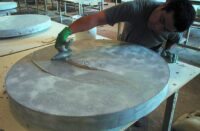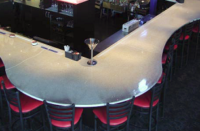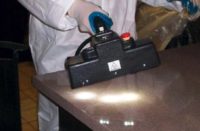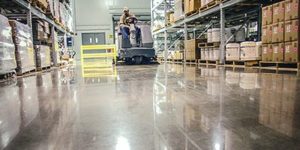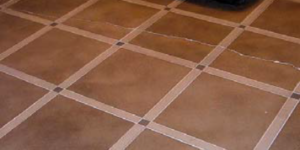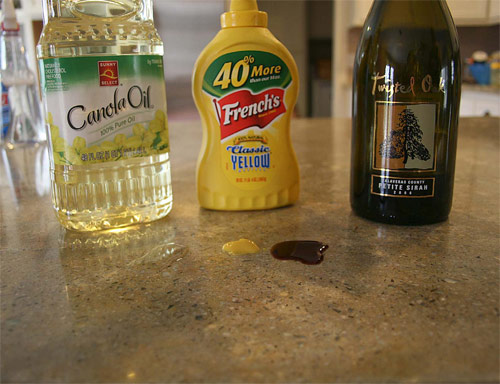
Think about what happens to a kitchen counter every day. People splash acids on it. They spill things that stain it, they chop and slice on it. Some even set hot pots and dishes down on it. And they clean and clean and clean it with water and chemicals and green scrub-pads.
“Concrete countertops are countertops made out of concrete,” says Jeffrey Girard, P.E., president of The Concrete Countertop Institute. “They’re not art, they’re not sculpture, and they’re not merely decorative. They’re countertops.” Their manufacture and performance must be consistent with the form, function and aesthetics of a countertop.
In many ways a countertop serves in a harsher environment than an outdoor patio, and yet it is held to a much higher visual standard. “You see a floor from five feet away,” says Mike Heidebrink, president of Cheng Concrete. “A counter is viewed from only two feet away, so it must deliver a very fine finished aesthetic.”
Concrete is a material perfect for countertops. It is durable, strong, versatile and beautiful. But it is also easily misunderstood by homeowners and, unfortunately, by some contractors too. After all, if you can drive on it, they think, why can’t you put a wine glass on it?
Countertops are not driveways, and they’re not floors. The concrete mix is different, and the methods for pouring or casting are different.
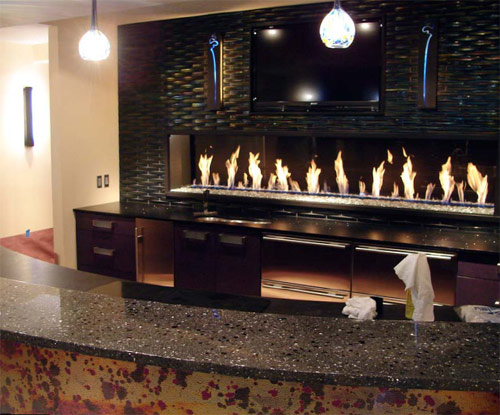
Equally important but perhaps less understood is the difference between sealers for flatwork and those for countertops. The right sealer plays a critical role in making a concrete slab, however beautiful, into a functioning kitchen counter.
What customers want
To keep a kitchen counter functional as well as beautiful, there are certain performance requirements homeowners want from a countertop sealer. “The number one objective for a countertop sealer is food safety,” according to Bill York, senior technical advisor for V-Seal Concrete Sealers.
After safety, the most important characteristic for most end users is chemical and stain resistance. Because unsealed concrete is porous, it is vulnerable to etching from acids like lemons or vinegar and stains from wine, even rings left by water glasses. Most customers want a sealer that will protect the concrete from this type of damage.
For home cooks, heat resistance is a significant benefit. They don’t want a sealer that will discolor or melt if they set a hot pot on it. Also, a sealer needs to resist abrasion. Abrasion resistance isn’t just important for keeping a countertop looking good. Scratches made by cutting on the counter or dragging rough objects over it dull the finish and create microfractures where bacteria can thrive.
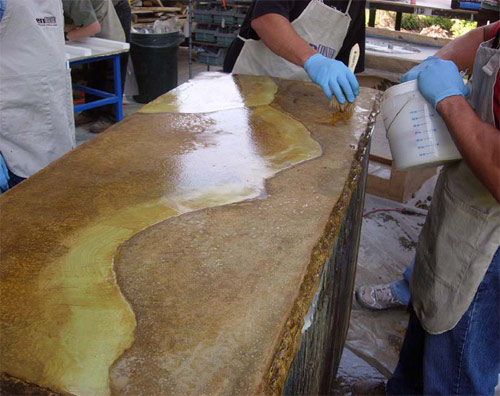
The last requirement on the list is the most subjective: the finish. Some customers want a high gloss for a modern, space-age look. At the other end, some customers want the counter to look just like concrete, as if there were no sealer on it. Most settle in the middle for a matte or satin finish that avoids the plastic look of a thick, glossy material, but still offers a protective coat between the food and the concrete.
What contractors can do
After years of research and product refinement, most countertop experts agree that the single perfect universal sealant remains undiscovered. So, short of perfection, how does a concrete artisan select the right sealer?
The most direct answer is to listen to proven experts, and here’s one good reason: often, you’re not just applying sealers, you’re applying sealer systems. Manufacturers and trainers who have been working with countertops for a long time have a track record of research and continuous improvement of sealer systems. Contractors can benefit from this research by selecting one of these proven systems, usually comprised of two or more materials, and becoming trained to use it rather than trying to develop their own system through trial and error.
Also, if they’ve been using the same sealer for a while, they should look at what’s new, especially in systems optimized for countertops. This is an area that shows continuous improvement, and even though sources agree the perfect sealer isn’t there yet, the options are getting better all the time.
Training the customer is also key. The end users need to know what different looks are available with different sealers. They also must know what trade-offs might need to be made. Additionally, knowing what their role is in maintaining and protecting the sealed surface is imperative. (The gift of a trivet or cutting board at the end of the project serves as both a nice gesture and a gentle reminder.)
The type of operation a contractor runs is also a factor in choosing a sealer system to work with. A shop producing large numbers of countertops at high speeds will probably want a rapidly curing system that can be automated. Studios working at lower volumes will not want to invest in the spray equipment or space required for such a system.
Sealing options
In the early days, there were very few options for fabricators. “The industry started out with floor sealers, stone sealers, even wood sealers. We had to use what was already available,” Heidebrink says. Sealer technology has advanced over the years and more options are available now. “There are finally sealers that are formulated for the stringent requirements of concrete countertops,” says Bob Chatterton of Surface 519. “But it is still hard to say if one material is better than another, as every sealer has different properties. Every project has different needs and conditions and every customer has different expectations. Sometimes the best a fabricator can do is make a list of what characteristics are important in a sealer. Then research which one covers the most items on that list and be ready to make at least one or two concessions.”
www.buddyrhodes.com
www.concretecountertopinstitute.com
www.concreteexchange.com (Cheng Concrete’s contractor network)
www.concretesolutions.com
www.surface519.com
www.vseal.com
